![]()
![]()
![]()
Use LEFT and RIGHT arrow keys to navigate between flashcards;
Use UP and DOWN arrow keys to flip the card;
H to show hint;
A reads text to speech;
36 Cards in this Set
- Front
- Back
|
Bone |
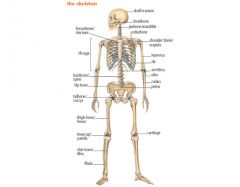
Hard, whitish tissue making up the skeleton in humans and other vertebrates
Resistant to tensile loading (aka can be compressed but not pulled out)
|
|
|
Cartilage |
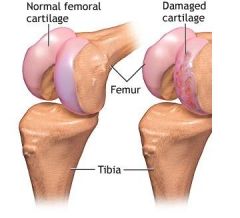
A tough, elastic, fibrous connective tissue found in various parts of the body
It makes up the embryonic and young vertebrate skeleton, then is converted to bone with aging
Resist compressive loading (cannot be compressed but can be stretched out)
Weight on tissues does not compress cartilage.
Found in joints, outer ear, and larynx
|
|
|
5 Types of bones (shapes) |
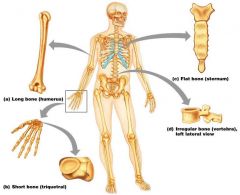
1. Long Bones 2. Short Bones 3. Flat Bones 4. Irregular Bones 5. Sesamoid Bones
|
|
|
Long Bones |

Have a body longer than it is wide
Growth plates (epiphysis) at either end, having a hard outer surface of compact bone and a spongy inner known an cancellous bone containing bone marrow.
Both ends of the bone are covered in hyaline cartilage to help protect the bone and aid shock absorbtion
ex. Femur, Humerus, Tibia, Metacarpals, Metatarsals and Phalanges. |
|
|
Short Bones |
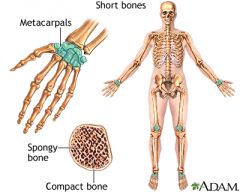
Approximately as wide as they are long
Have a primary function of providing support and stability, little movement.
Consist of only a thin layer of compact, hard bone with cancellous bone on the inside along with relatively large amounts of bone marrow.
Ex. Carpals and Tarsals - the wrist and foot bones. |
|
|
Flat Bones |
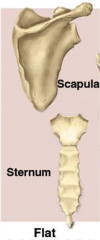
Strong, flat plates of bone
Main function is protection to the bodies vital organs and being a base for muscular attachment.
Anterior and posterior surfaces are formed of compact bone to provide strength for protection with the centre consisiting of cancellous (spongy) bone and varying amounts of bone marrow.
In adults, the highest number of red blood cells are formed in flat bones.
Ex. Scapula (shoulder blade), Sternum (breast bone), Cranium (skull), os coxae (hip bone), Pelvis, and Ribs |
|
|
Sesamoid bones |
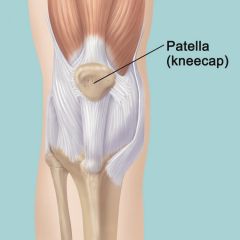
Short or irregular bones, imbedded in a tendon. Sesamoid bones are usually present in a tendon where it passes over a joint which serves to protect the tendon.
Ex. Patella (knee cap) which sits within the Patella or Quadriceps tendon. Other sesamoid bones are the Pisiform (smallest of the Carpals) and the two small bones at the base of the 1st Metatarsal. |
|
|
Irregular Bones |
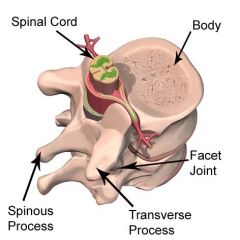
Do not fall into any other category, due to their non-uniform shape.
They primarily consist of cancellous bone, with a thin outer layer of compact bone.
Ex. Vertebrae, Sacrum and Mandible (lower jaw) |
|
|
Spongy Bone |

aka Trabecular Bone
aka Cancellous bone
Soft, weak, flexible, not dense
Has plates that are laid down in a regular pattern in regard to stress on the bone. |
|
|
Compact Bone |
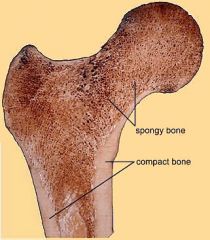
aka Cortical Bone
Dense, stiff bone
Note - osteoporosis can affect both types of bone |
|
|
Lamellar Bone |
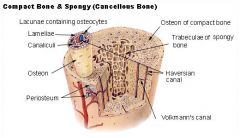
Normal type of adult mammalian bone (cancellous or compact)
Note - Compact (cortical) and cancellous (trabecular) are gross descriptive terms; Woven (disorganized fetal bone) and lamellar are histological descriptors
"Lamella" = thin layer
Cancellous is composed of parallel lamellae Compact is composed of concentric lamellae Interstitial lamellae are randomly oriented
*Note: osteons run parallel to long axis of the bone |
|
|
Woven Bone |
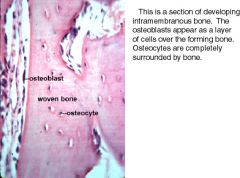
Fetal bone, removed during maturation
Randomly dispersed, disorganized collagen
Osteoblasts on outside, canaliculi randomly placed
Mechanically weak
|
|
|
Bone Matrix |
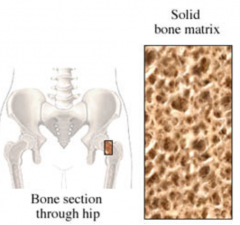
The intercellular substance of bone tissue consisting of collagen fibers, ground substance, and inorganic bone salts. |
|
|
Ground substance |
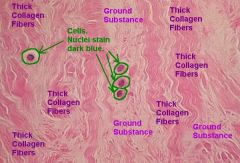
A gel-like substance surrounding the cells of connective tissue
Primarily composed of water, glycosaminoglycans (hyaluronan), proteoglycans, and glycoproteins
Components vary depending on the tissue
aka "extra fibrillar matrix"
Does not include fibers (collagen and elastic fibers), but does include all the other components of the extracellular matrix
Usually it is not visible on slides, because it is removed during the preparation process |
|
|
Hydroxyapatite |
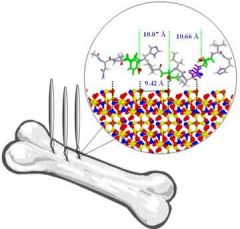
Main inorganic compound of bone
a mineral that gives stiffness and tensile strength to bones
inserts as granules or sheets between collagen fibrils (in gaps/holes)
|
|
|
Fibrous matrix of bone |
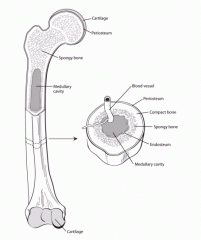
99 % Collagen, 1 % Ground Substance
Bone mineral are placed in holes between staggered collagen models
|
|
|
Trabecula |
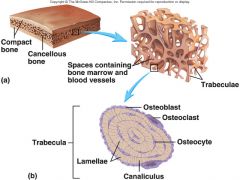
Functional unit of trabecular (spongy) bone
A small beam of connective tissue
Provides support and structure
In osteoporosis, there is loss of the trabeculae in the plates, leaving very thin bars of bone. |
|
|
Osteon
(aka "haversian system") |

Functional unit of compact bone
A central canal containing blood capillaries and the "concentric" lamellae around it
In the center of the osteon is a blood vessel. This space is called the Haversian Canal by some investigators. It is surrounded by concentric lamellar structures. Outside this “solar system” are some interstitial lamellae that lie at the interface between one osteon and another due to remodeling of bone. |
|
|
Lacunae |

a gap or unfilled space
one of the numerous minute cavities in the substance of bone that contain nucleate cells |
|
|
Canaliculi |

Microscopic ducts between the lacunae of ossified bone
Materials picked up by osteocytes adjacent to blood vessels are distributed throughout the bone matrix via the canaliculi
Extend out to neighboring cells via gap junctions |
|
|
Osteocytes |
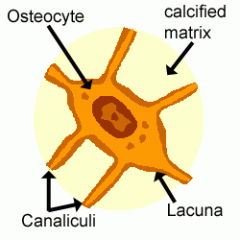
A branched cell embedded in the matrix of bone tissue.
Can live as long as the organism itself, do not divide
Derived from osteoblasts: when osteoblasts become trapped in the matrix that they secrete, they become osteocytes.
Osteocytes are found in spaces called lacunae and their processes are found in canaliculi
Osteocytes are networked to each other via long cytoplasmic extension in canaliculi, which are used for exchange of nutrients and waste through gap junctions. The processes also interact with surrounding matrix by integrin receptors.
Although osteocytes have reduced synthetic activity and (like osteoblasts) are not capable of mitotic division, they are actively involved in the routine turnover of bony matrix, through various mechanosensory mechanisms.
Bone lining cells also communicate with the osteocytes within the bone. These bone lining cells determine where and when new bone is deposited.
The network of osteocytes is critical for overall biomechanical process. If there is drop out of even a few osteocytes, the mechanical characteristics of the bone are degraded, so there must be turnover of the osteocytes to repair damage.
|
|
|
3 Types of Cartilage |

1. Hyaline - transparent cartilage, found on joint surfaces, simple structure, firm consistency with a lot of collagen. It contains no nerves or blood vessels.
2. Fibro-cartilage - contains organized fibrous bundles of collagen with lines of cells in between, good for areas under tension (like the intervertebral disks in the spinal cord)
|
|
|
Aggrecan |
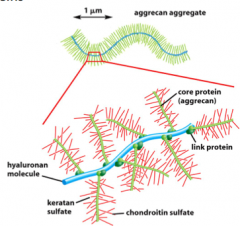
Main component of cartilage
A proteoglycan with type II collagen
Major part of the ground substance of cartilage
Attracts water and acts as lubricant
Aggrecan is composed of monomers hyaluronic acid linked along the length of the core protein. The hyaluronic acid are extended GAGs (chondroitin sulfate + keratin sulfate)
Aggrecan has fixed negative charges and hence resistance to compression is due to electrostatic repulsion.
The charges hold water in these feathered domains and it swells. |
|
|
Fibrous matrix of Cartilage |
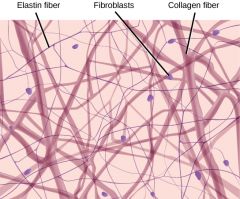
50% collagen (with occasional elastic fibers), 50% ground substance
Collagens form (micro)fibrils that are smaller than bone |
|
|
2 Types of Bone/Cartilage Growth |
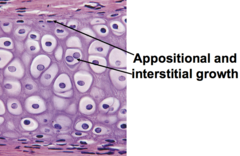
Appositional (bone and cartilage) -
Growth by forming new layers on the surface of pre-existing layers
Process of increasing in thickness rather than length
Interstitial (cartilage only) -
growth from a number of different centers within an area;
cells in the center grow, divide, and spread out
In contrast with appositional growth, it can occur only when the materials involved are nonrigid, such as cartilage. |
|
|
2 essential processes by which bone tissue is created (during fetal development) |
1. Endochondral Ossification 2. Intramembrous Ossification |
|
|
Endochondrial Ossification |

Uses hyaline cartilage “bones” as models for bone construction
Most bones
Requires breakdown of hyaline cartilage prior to ossification & formation begins at the primary ossification center
The perichondrium covering the hyaline cartilage “bone” is infiltrated with blood vessels converting it to vascularized periosteum. This change in nutrition causes the underlying mesenchymal cells to specialize into osteoblasts.
1. Formation of bone collar - Osteoblasts of the converted periosteum secrete osteoid against the hyaline cartilage diaphysis encasing it in a bone collar
2. Cavitation of the hyaline cartilage - Chondrocytes within the shaft hypertrophy & signal surrounding cartilage matrix (VEGF) to calcify. Chondrocytes die due to lack of nutrients (impermeability of calcified matrix). Matrix deteriorates thus opening up cavities
3. Invasion of internal cavities by the periosteal bud, and spongy bone formation - The forming cavities are invaded by a collection of elements : Periosteal bud contains a nutrient artery and vein, lymphatics, nerve fibers, red marrow elements, osteoblasts, and osteoclasts. Osteoclasts erode the calcified cartilage matrix & osteoblasts secrete osteoid around the remaining hyaline cartilage forming bone-covered cartilage trabuculae (the formation of spongy bone)
4. Formation of the medullary cavity; appearance of secondary ossification centers in the epiphyses - Osteoclasts open up a medullary cavity by breaking down the newly formed spongy bone. Cartilage is growing, bones being calcified and eroded and then replaced by bony spicules on the epiphyseal surfaces facing the medullary cavity.
5. Ossification of the epiphyses - Secondary ossification centers appear in one or both epiphyses. Steps 1-4 occur there except no medullary cavity forms. Finally, hyaline cavity remains at Epiphyseal surface (articular cartilage) & Epiphyseal plates (junction of the diaphysis and the epiphysis) |
|
|
Intramembranous growth |
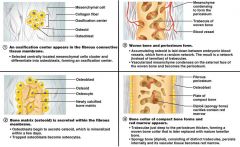
Cartilage not present
Skull and clavicle
1. Ossification center appears in fibrous connective tissue membrane
2. Bone is secreted within the fibrous membrane
3. Woven bone & periosteum form
4. Bone collar of compact bone and red marrow appear
mesenchymal condensation=>bone tissue directly without any other intermediate structures such as the cartilage model (which defines endochondral development—see above).
This bone sheet forms between two membranes such as for example the dura mater and scalp in skull bones.
The osteocytes are embedded in the matrix.
Growth of the intramembranous bone occurs at suture lines where plates of intramembranous bone meet.
Osteoblasts are on the matrix surface in the so called periosteum. |
|
|
Indian Hedgehog
PTHrP |
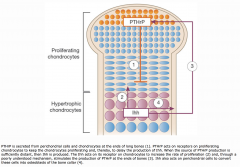
Indian Hedgehog (pro-ossification) - released by herterotrophic chondrocytes, stimulates chondrocytes to proliferate, also periosteal cells to release PTHrP
PTHrP (limits ossification) - inhibits ossification by inhibiting the release of Indian Hedgehog so that too much doesn't happen |
|
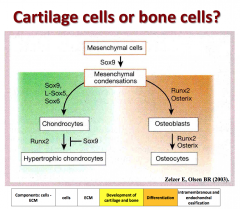
Determination of Bone and Cartilage |
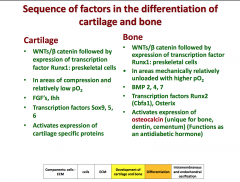
1) Initial Mesenchyme Condensations: Wnt signaling drives mesenchymal condensation as a result of Sox9/Runx1 expression.
2) In areas of high oxygen and some tensile stress bone forms. BMP 2, 4, 7, then runx2 and osterix=> activates osteocalcin and drives bone formation
3) In areas of low oxygen tension and intermittent compression, Indian hedgehog and FGF activate and expression of Sox9, Sox5, Sox6 drives the progenitor cell to chondrocytes. |
|
|
Bone Remodeling |

Purpose - To replace old bone tissue with new To reflect changed biomechanical loading patterns (strain and damage resulting in microcracks) In response to hormonal changes In response to pathologic conditions (e.g., inflammation)
Osteoblasts on the bone surface lay down new bone by secreting un- mineralized material “osteoid”. Some become mature periosteal bone lining cells, and some become osteocytes in the middle of the bone.
When the bone tissue is loaded there is pressure on the canniliculi. These osteocytic process senses stress via integrins and via stretch activated Ca2+ channels. The bone cell network within the bone sends information to osteoblasts on the bone surface to direct them to proliferate and to lay down new osteoid. |
|
|
Effects of hormones on skeletal metabolism (aka which increase bone resorbtion, which decrease it) |
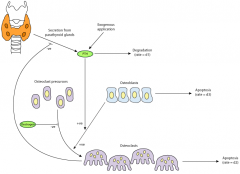
• Increase bone resorption – Parathyroid hormone
• Decrease bone resorption – Calcitonin – Gonadal steroids |
|
|
Bone Remodeling signals: Sclerostin (Osteocytes - Osteoblasts) |
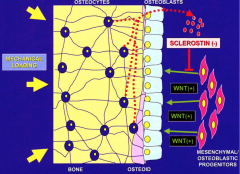
Osteocytes - Osteoblasts : The osteocytes make sclerostin under normal conditions, blocking Wnt signaling (which normally stimulates osteoblast proliferation)
Sclerostin is produced when there is no pressure loading, but when osteocytes are fully loaded they stop producing Sclerostin and Wnt induces more osteoblasts to form. Thus, new bone is created under mechanical load. This occurs rapidly. |
|
|
Bone Remodeling Signals : RANKL, RANK, & OPG (Osteoblast - Osteoclasts) |
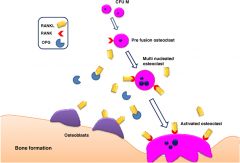
RANKL - produced by osteoblasts
RANK - receptor on Osteoclasts for RANKL
OPG (osteoprotegerin) - a soluble inhibitor made by osteoblasts that limits osteoclast maturation.
When RANKL binds to RANK, this induces pre-Osteoclasts to mature to functional Osteoclasts, allowing them to dissolve bone.
OPG binds RANKL and inhibits RANKL availability.
Activated osteoclasts sit on bone in the Howship’s lacuna and use H+ATPase to dissolve hydroxyappitite.
The ruffled boarder is used to absorb and cause transcytosis of degraded collagen fragments that contain hydroxyproline.
Degradation of bone by osteoclasts releases activated TGF beta which, in contrast, stimulates new bone tissue formation (one aspect of balance).
The osteoclast produces a “cement line”, a residual discontinuity of new and old bone.
Note that the osteoclasts are active both on the surface of the bone as well as in the center of the osteons where the blood vessels lie.
During inflammatory conditions, the ratio of Rankl/OPG changes. The inflammatory cells make Rankl and osteoclasts are activated and bone is reabsorbed. |
|
|
Bone
-Composition -Collagen types -Special Features -Lacunae Characteristics -Developmental Origin -Location/environment -Growth Mechanism |
-Composition : Fibrous matrix is 99.6% of demineralized dry weight Ground substance is 0.4% of dry weight
-Collagen types : Collagen I (main fibrils) Collagen V (embedded, nucleating)
-Lacunae Characteristics : Interconnected thru canaliculi processes, communication between lacuna thru gap junctions
-Location/environment : Forms in areas of high pO2 and high tensile loading
-Growth Mechanism : Appositional only
-Developmental Origin : Mesenchymal: differentiation due to Runx, etc. TFs |
|
|
Cartilage
-Composition -Collagen types -Special Features -Lacunae Characteristics -Developmental Origin -Location/environment -Growth Mechanism |
-Composition : Fibrous matrix is 50% of dry weight Ground substance is 50% of dry weight
-Collagen types : Collagen 2 (main fibrils)
-Lacunae Characteristics : Isolated, completely enclosed, no communication (except thru the ECM)
-Location/environment : In areas of low pO2 and high compressive loading
-Growth Mechanism : Appositional and interstitial
-Developmental Origin : Mesenchymal: differentiation due to Sox TFs
|

